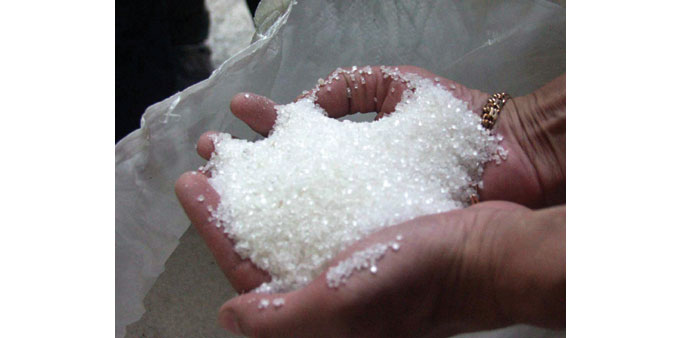Sugar output in India, the world’s biggest producer after Brazil, will probably fall short of demand for the first time in six years after a lack of monsoon rain cut crop yields, according to Indian Sugar Mills Association data.
Bloomberg
Mumbai
Sugar output in India, the world’s biggest producer after Brazil, will probably fall short of demand for the first time in six years after a lack of monsoon rain cut crop yields.
Production may total 23.08mn metric tonnes in the marketing year that began on October 1, according SGS SA, a researcher hired by Bloomberg to survey farmers in the main growing regions during September and October. That’s the lowest since the 18.9mn ton-crop in 2009-10, according to Indian Sugar Mills Association data. The association forecasts output at 27mn tonnes this season and domestic demand of 26mn tonnes.
After a five-year global glut that pushed prices down in the longest run of annual declines in more than five decades, demand is expected to outstrip world supply this season. El Nino curbed India’s monsoon rainfall to the lowest since 2009, with the first back-to-back shortfall in three decades wilting crops and cutting water levels in the nation’s main dams. A smaller harvest may reduce exports and cut local reserves that jumped 21% on October 1.
“Global sugar stocks would decrease due to falling stocks in India,” Carsten Fritsch, an analyst at Commerzbank in Frankfurt, said by e-mail. “India would export sugar from its very high inventories. Hence, supply on the world market would not be affected.” Raw sugar futures for March delivery rose 0.4% to 15.01 cents a pound on the ICE Futures US in New York at 4:32 pm in Singapore on Friday. Prices have surged 48% since reaching a seven-year low in August.
“There just wasn’t enough rain in the key growing areas this year,” Mark Oulton, global agricultural market research manager with SGS, said from Shanghai. “We’ve really seen the bad effects of an El Nino for two years in a row now. India is highly vulnerable to El Ninos and sugarcane was no exception.” The cane harvest will drop 4.9% to 341.79mn tons this season, according to the SGS survey conducted between September 26 and October 16 across six states including top producers Uttar Pradesh and Maharashtra. About 66% of cane may be crushed to make sugar, according to SGS, which used the average extraction rate of 10.3% between 2000-01 and 2012-13 and reported by the country’s cooperative producers. The rest will be used for livestock feed, seeding and jaggery, a local sweetener, SGS said.
The 861 interviews with farmers were determined to obtain a 95% confidence level, with a margin of error of 3.26%, according to SGS.
India’s monsoon rainfall was 14% below the 50-year average of 89 centimeters (35 inches) between June and September, according to the Indian Meteorological Department.
The monsoon accounts for about 80% of the country’s total rainfall and waters more than half its farmland. The El Nino weather phenomenon that can bake parts of Asia is the strongest since the 1997-98 event, according to Australia’s weather bureau.
Farmers planted 1.7% less cane, with declines in Tamil Nadu, Andhra Pradesh and Uttar Pradesh, the survey showed.
The area increased in Maharashtra and Karnataka. National yields may drop 3.2%, SGS said. Reporting of bad crop conditions increased to 12% from 6% a year earlier, while good crop conditions fell to 21% from 27%, it said.
The cane harvest in Uttar Pradesh, the nation’s biggest grower of the crop and second-largest sugar producer, will probably drop 3.9%, according to SGS. Production in Tamil Nadu may slump 31%, while Karnataka’s output will probably decline 2.1%, it said. The harvest in Maharashtra, the biggest sugar producer, will probably increase 0.4%, it said.
SGS had predicted India’s 2014-15 sugar production at 26.25mn tonnes compared with Indian Sugar Mills Association’s final estimate of 28.3mn tonnes. Its survey-based estimate of 24.42mn tonnes for 2013-14 almost matched the final output figures of 24.55mn tonnes from the government and 24.39mn tonnes from the mills association.



